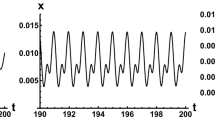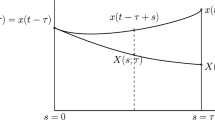Abstract
Sensitivity analyses are of paramount importance in ecological and evolutionary theories, but their application to continuous time models has been virtually ignored from these fields. We present a simple and general method that makes this analysis possible for any model specified by a system of ordinary differential equations, using the direct method from mathematical theory. The resulting analysis may be used to study the effect of parameter perturbation on the whole trajectories of the state variables as well as for deriving the sensitivity of composite metrics such as the population growth rate. We also present methods for analyzing the sensitivity of discrete events within a continuous-time framework, such as the age at maturation, where timing may be affected by the perturbation. These methods are applied to a model for the energetics of individual growth, reproduction, and mortality. The method is versatile and can be applied to study transient as well as asymptotic dynamics, and its application may benefit many fields of ecology and evolution.


Similar content being viewed by others
References
Andersen T, Carstensen J, Hernandez-Garcia E, Duarte CM (2009) Ecological thresholds and regime shifts: approaches to identification. Trends Ecol Evol 24(1):49–57
Benton TG, Grant A (1999) Elasticity analysis as an important tool in evolutionary and population ecology. Trends Ecol Evol 14(12):467–471
Buzby M, Neckels D, Antolin MF, Estep D (2008) Analysis of the sensitivity properties of a model of vector-borne bubonic plague. J Roy Soc Interface 5(26):1099–1107
Cacuci DG (1981) Sensitivity theory for nonlinear systems. i. nonlinear functional analysis approach. J Math Phys 22(12):2794–2802
Caswell H (2001) Matrix population models. Wiley Online Library
Caswell H (2007) Sensitivity analysis of transient population dynamics. Ecol Lett 10(1):1–15
Caswell H (2008) Perturbation analysis of nonlinear matrix population models. Demogr Res 18(3):59–116
Caswell H (2009) Sensitivity and elasticity of density-dependent population models. J Differ Equ Appl 15(4):349–369
Chaniotis D, Pai M, Hiskens I (2001) Sensitivity analysis of differential-algebraic systems using the GMRES method-application to power systems. IEEE, vol 3, pp 117–120
Day T, Rowe L (2002) Developmental thresholds and the evolution of reaction norms for age and size at life-history transitions. Am Nat 159(4):338–350
De Roos AM (2008) Demographic analysis of continuous-time life-history models. Ecol lett 11(1):1–15
De Roos AM, Persson L (2003) Competition in size-structured populations: mechanisms inducing cohort formation and population cycles. Theor Popul Biol 63(1):1–16
Dickinson RP, Gelinas RJ (1976) Sensitivity analysis of ordinary differential equation systemsa direct method. J Comput Phys 21(2):123–143
Dunker AM, Yarwood G, Ortmann JP, Wilson GM (2002) The decoupled direct method for sensitivity analysis in a three-dimensional air quality model implementation, accuracy, and efficiency. Environ Sci Technol 36(13):2965–2976
Easterling MR, Ellner SP, Dixon PM (2000) Size-specific sensitivity: applying a new structured population model. Ecology 81(3):694–708
Ernande B, Dieckmann U, Heino M (2004) Adaptive changes in harvested populations: plasticity and evolution of age and size at maturation. P Roy Soc Lond B Bio 271(1537):415–423
Geritz SA, Metz JAJ, Kisdi É, Meszéna G (1997) Dynamics of adaptation and evolutionary branching. Phys Rev Lett 78(10):2024
Geritz SA, Kisdi É, Meszéna G, Metz JAJ (1998) Evolutionarily singular strategies and the adaptive growth and branching of the evolutionary tree. Evol Ecol 12(1):35–57
Groffman PM, Baron JS, Blett T, Gold AJ, Goodman I, Gunderson LH, Levinson BM, Palmer MA, Paerl HW, Peterson GD (2006) Ecological thresholds: the key to successful environmental management or an important concept with no practical application? Ecosystems 9(1):1–13
Gurney W, Nisbet RM (1998) Ecological dynamics. Oxford University Press, Oxford
Hazel W, Smock R, Johnson M (1990) A polygenic model for the evolution and maintenance of conditional strategies. P Roy Soc Lond B Bio 242(1305):181–187
Hazel W, Smock R, Lively CM (2004) The ecological genetics of conditional strategies. Am Nat 163(6):888–900
Justus J (2006) Loop analysis and qualitative modeling: limitations and merits. Biol Philos 21(5):647–666
Kendall BE, Briggs CJ, Murdoch WW, Turchin P, Ellner SP, McCauley E, Nisbet RM, Wood SN (1999) Why do populations cycle? a synthesis of statistical and mechanistic modeling approaches. Ecology 80(6):1789–1805
Klausmeier CA (2008) Floquet theory: a useful tool for understanding nonequilibrium dynamics. Theor Ecol 1(3):153–161
Koda M, Dogru AH, Seinfeld JH (1979) Sensitivity analysis of partial differential equations with application to reaction and diffusion processes. J Comput Phys 30(2):259–282
Larter R (1983) Sensitivity analysis of autonomous oscillators, separation of secular terms and determination of structural stability. J Phys Chem-US 87(16):3114–3121
Levins R (1974) The qualitative analysis of partially specified systems. Ann N Y Acad Sci 231:123138
Li S, Petzold LR (2003) Solution adapted mesh refinement and sensitivity analysis for parabolic partial differential equation systems. In: Large-scale PDE-constrained optimization. Springer, Berlin Heidelberg New York, pp 117–132
Lu P, Yue H (2012) Developing objective sensitivity analysis of periodic systems: case studies of biological oscillators. Acta Autom Sin 38(7):1065–1073
McCauley E, Nelson WA, Nisbet RM (2008) Small-amplitude cycles emerge from stage-structured interactions in Daphnia-algal systems. Nature 455(7217):1240–1243
Metcalf CJE, Pavard S (2007) Why evolutionary biologists should be demographers. Trends Ecol Evol 22(4):205–212
Nisbet RM, McCauley E, Gurney WSC, Murdoch WW, Wood SN (2004) Formulating and testing a partially specified dynamic energy budget model. Ecology 85(11):3132–3139
Nisbet RM, McCauley E, Johnson LR (2010) Dynamic energy budget theory and population ecology: lessons from Daphnia. Philos T Roy Soc B 365(1557):3541–3552
Perumal TM, Gunawan R (2011) Understanding dynamics using sensitivity analysis: caveat and solution. BMC Syst Biol 5(1):41
Petzold L, Li S, Cao Y, Serban R (2006) Sensitivity analysis of differential-algebraic equations and partial differential equations. Comput Chem Eng 30(10):1553–1559
Rihan FA (2003) Sensitivity analysis for dynamic systems with time-lags. J Comput Appl Math 151(2):445–462
Roff DA (1996) The evolution of threshold traits in animals. Q Rev Biol:3–35
Roff DA (2002) Life history evolution, vol 7. Sinauer Associates Sunderland
Shiraishi F, Tomita T, Iwata M, Berrada AA, Hirayama H (2009) A reliable taylor series-based computational method for the calculation of dynamic sensitivities in large-scale metabolic reaction systems: algorithm and software evaluation. Math Biosci 222(2):73–85
Stewart J (2007) Calculus: early transcendentals, 6th edn. Cengage Learning, Belmont
Tavener S, Mikucki M, Field SG, Antolin MF (2011) Transient sensitivity analysis for nonlinear population models. Methods Ecol Evol 2(5):560–575
Tolsma JE, Barton PI (2002) Hidden discontinuities and parametric sensitivity calculations. SIAM J Sci Comput 23(6):1861–1874
Tomovic R, Vukobratovic M (1972) General sensitivity theory. American Elsevier, New York
Tortorelli DA, Michaleris P (1994) Design sensitivity analysis: overview and review. Inverse Probl Eng 1(1):71–105
Verdy A, Caswell H (2008) Sensitivity analysis of reactive ecological dynamics. Bull Math Biol 70(6):1634–1659
Wilkins AK, Tidor B, White J, Barton PI (2009) Sensitivity analysis for oscillating dynamical systems. SIAM J Sci Comput 31(4):2706–2732
Wu WH, Wang FS, Chang MS (2008) Dynamic sensitivity analysis of biological systems. BMC Bioinf 9(Suppl 12):S17
Zi Z (2011) Sensitivity analysis approaches applied to systems biology models. IET Syst Biol 5(6):336–346
ZivariPiran H, Enright WH (2009) Accurate first-order sensitivity analysis for delay differential equations: Part i: The forward approach. preprint, Department of Computer Science, University of Toronto
Acknowledgments
We are grateful to Andre de Roos and Hal Caswell for thorough comments on the manuscript, and to Ottar Bjornstad and Jeremy Fox for useful discussions. This work was supported by Ed McCauley’s NSERC Accelerator Award and Operating Grant, Canada Research Chair, and grants from the Water Research Institute. Romain Richard received additional support from a Pacific Institute for the Mathematical Sciences IGTC fellowship in mathematical biology.
Author information
Authors and Affiliations
Corresponding author
Rights and permissions
About this article
Cite this article
Richard, R., Casas, J. & McCauley, E. Sensitivity analysis of continuous-time models for ecological and evolutionary theories. Theor Ecol 8, 481–490 (2015). https://doi.org/10.1007/s12080-015-0265-9
Received:
Accepted:
Published:
Issue Date:
DOI: https://doi.org/10.1007/s12080-015-0265-9




